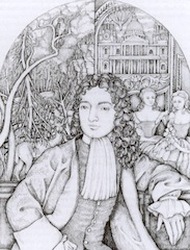|
J. William T. "Bill" Youngs, American Realities, Volume One:
Historical Episodes from First Settlements to the Civil War, Chapter Three |
Westover Plantation, William Byrd's Virginia Home,
Courtesy of Wikipedia Commons |
3. The British American
|
|
|
This essay explores the American identity in the colonial period. In William Byrd’s story we see a man torn between his attachments to England and to America. In the eighteenth century the two identities could pull the settlers in seemingly opposite directions. Byrd’s life introduces us to several important facets of colonial life, including politics, trade, and society. And it reminds us of America’s continuing political and psychological link to the “mother country” during the colonial years.
|
Author Reads From the Text
The sun went down behind the steep, forested ridge of the Alleghenies. Resplendent stars shone brightly in the clear autumn sky while bear, deer, and opossum foraged among the darkened trees. In the midst of a vast and potent wilderness there glowed a solitary campfire, a flickering circle of light illuminating tents, horses, and a cluster of men.
The men standing by the campfire were working their way through swamps and brush surveying a dividing line between the colonies of Virginia and North Carolina. Their supplies had long since run low, and most of their horses were lame. Nonetheless, their camp was festive: this was October 30, 1728, the king’s birthday, and patriotism led them to consume spirits and discharge fireworks in celebration. The men were doing their best, toasting King George II with the last of their liquor, a bottle of cherry brandy carefully preserved by their leader, William Byrd, and drinking to the queen and all her royal progeny with drafts of pure water from an Allegheny tributary. To complete the celebration, they set off explosives, fashioned of green cane from a nearby field and laid in the fire. The air within the cane joints expanded and punctured the night air with loud and satisfying bangs.
When William Byrd recorded this episode, he considered it natural to honor the English king. Although he was a third-generation Virginian, he regarded himself as an Englishman and was accustomed to celebrating his transatlantic heritage. In the middle period of colonial history, Byrd lived in two worlds — provincial Virginia and Georgian England. It was as natural for him to observe the king’s birthday in the American wilderness as for any British subject in London. Byrd’s history, remarkable for his dramatic and wide-ranging achievements, highlights important features of British-American life. Byrd was many things — planter, gentleman, politician, writer, and lover. A contemplative as well as an active man, he sought to live a full and dignified life alternately as a London gentleman and as a southern planter. In certain respects he succeeded in standing astride the Atlantic, half British and half American; yet his life also exhibits a tension between the two worlds. As an American he was unable to achieve the stature he sought in London; as an Englishman he had difficulty feeling at ease in Virginia…
The men standing by the campfire were working their way through swamps and brush surveying a dividing line between the colonies of Virginia and North Carolina. Their supplies had long since run low, and most of their horses were lame. Nonetheless, their camp was festive: this was October 30, 1728, the king’s birthday, and patriotism led them to consume spirits and discharge fireworks in celebration. The men were doing their best, toasting King George II with the last of their liquor, a bottle of cherry brandy carefully preserved by their leader, William Byrd, and drinking to the queen and all her royal progeny with drafts of pure water from an Allegheny tributary. To complete the celebration, they set off explosives, fashioned of green cane from a nearby field and laid in the fire. The air within the cane joints expanded and punctured the night air with loud and satisfying bangs.
When William Byrd recorded this episode, he considered it natural to honor the English king. Although he was a third-generation Virginian, he regarded himself as an Englishman and was accustomed to celebrating his transatlantic heritage. In the middle period of colonial history, Byrd lived in two worlds — provincial Virginia and Georgian England. It was as natural for him to observe the king’s birthday in the American wilderness as for any British subject in London. Byrd’s history, remarkable for his dramatic and wide-ranging achievements, highlights important features of British-American life. Byrd was many things — planter, gentleman, politician, writer, and lover. A contemplative as well as an active man, he sought to live a full and dignified life alternately as a London gentleman and as a southern planter. In certain respects he succeeded in standing astride the Atlantic, half British and half American; yet his life also exhibits a tension between the two worlds. As an American he was unable to achieve the stature he sought in London; as an Englishman he had difficulty feeling at ease in Virginia…

